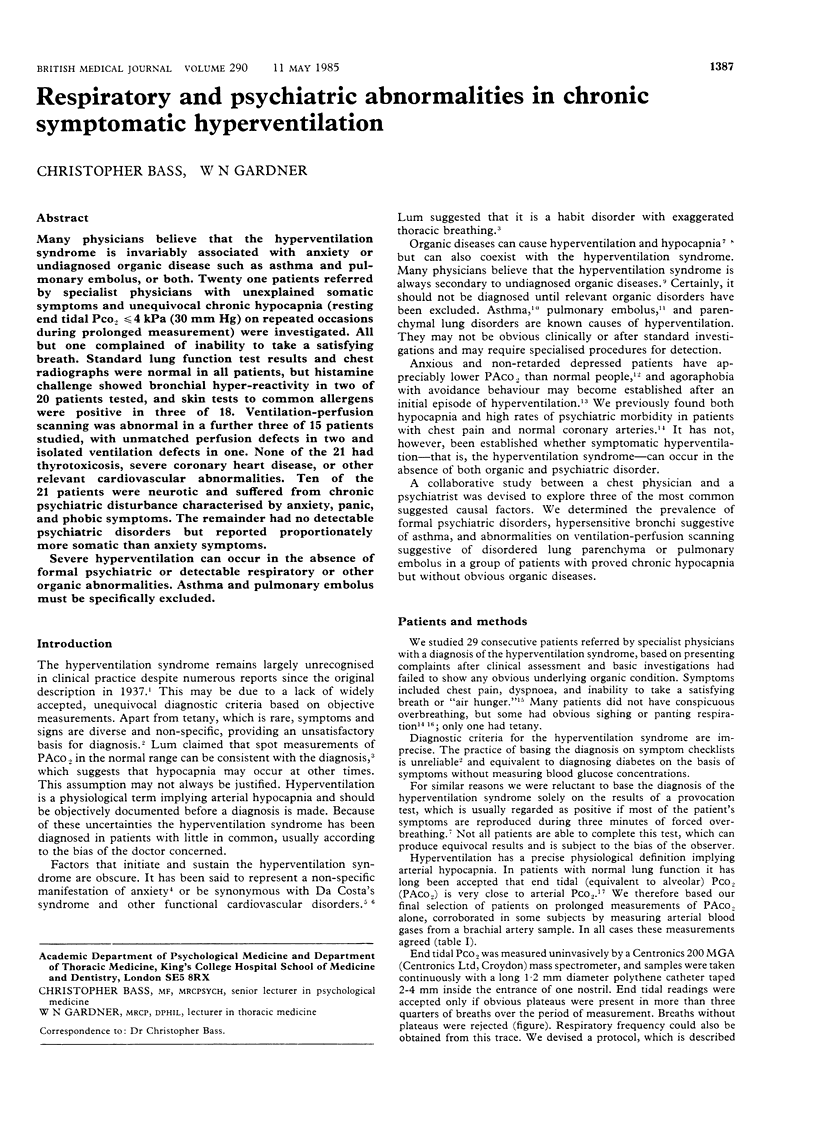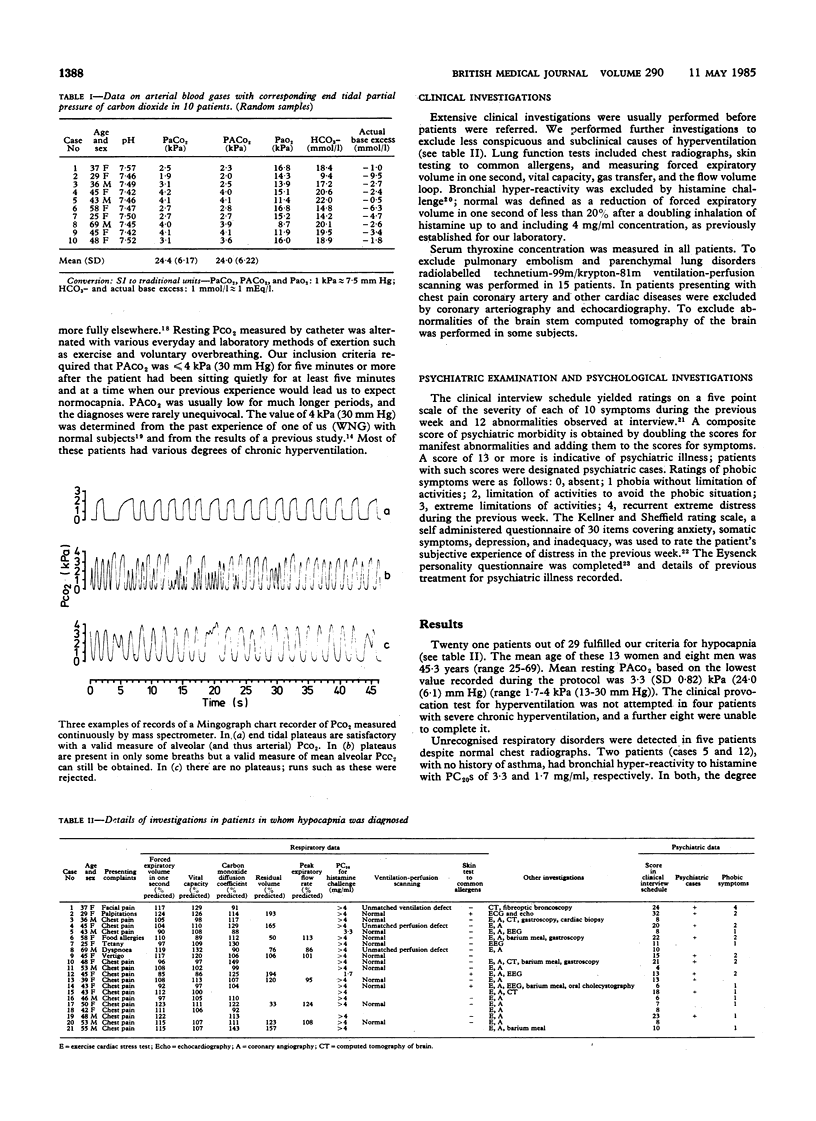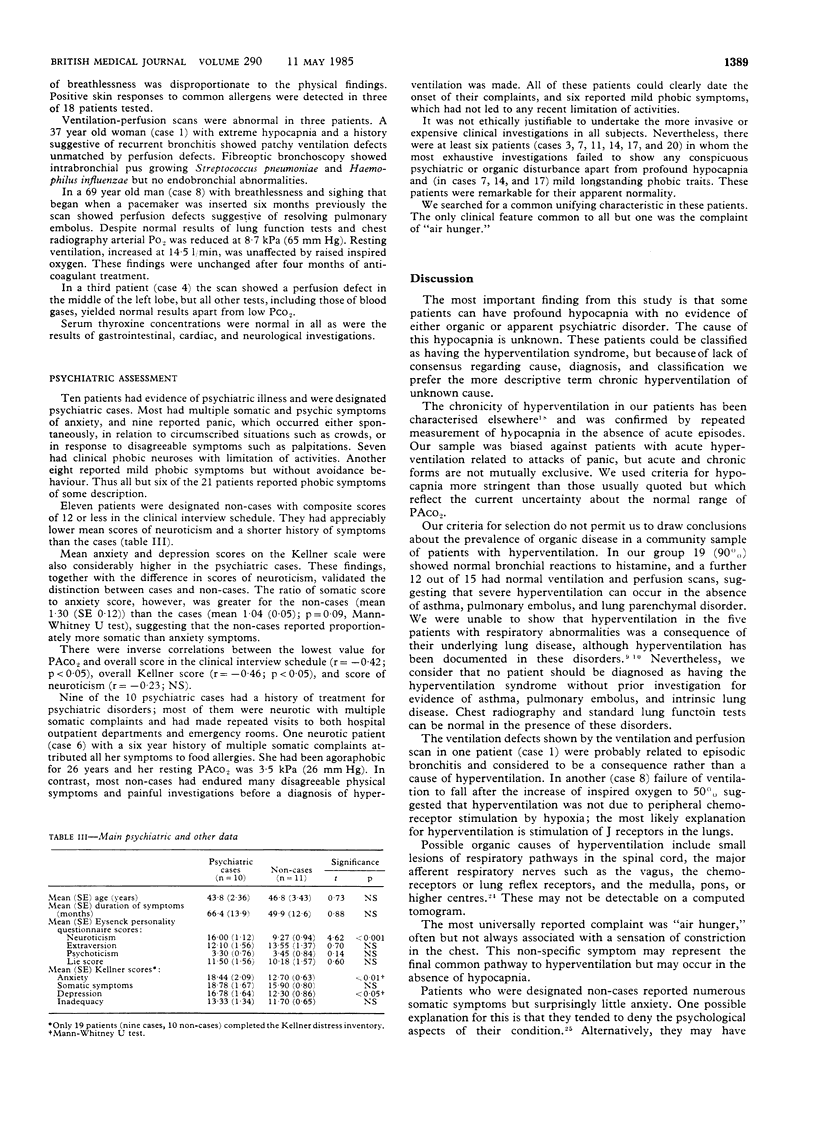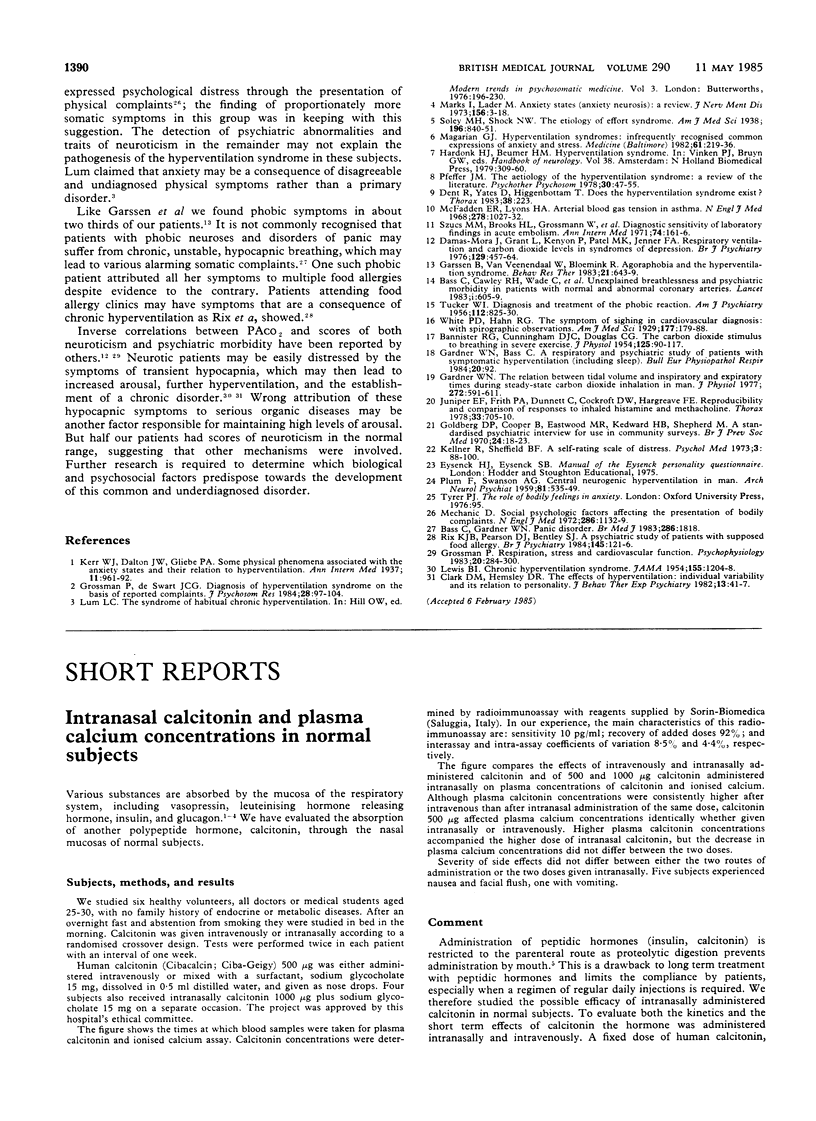Abstract
Many physicians believe that the hyperventilation syndrome is invariably associated with anxiety or undiagnosed organic disease such as asthma and pulmonary embolus, or both. Twenty one patients referred by specialist physicians with unexplained somatic symptoms and unequivocal chronic hypocapnia (resting end tidal Pco2 less than or equal to 4 kPa (30 mm Hg) on repeated occasions during prolonged measurement) were investigated. All but one complained of inability to take a satisfying breath. Standard lung function test results and chest radiographs were normal in all patients, but histamine challenge showed bronchial hyper-reactivity in two of 20 patients tested, and skin tests to common allergens were positive in three of 18. Ventilation-perfusion scanning was abnormal in a further three of 15 patients studied, with unmatched perfusion defects in two and isolated ventilation defects in one. None of the 21 had thyrotoxicosis, severe coronary heart disease, or other relevant cardiovascular abnormalities. Ten of the 21 patients were neurotic and suffered from chronic psychiatric disturbance characterised by anxiety, panic, and phobic symptoms. The remainder had no detectable psychiatric disorders but reported proportionately more somatic than anxiety symptoms. Severe hyperventilation can occur in the absence of formal psychiatric or detectable respiratory or other organic abnormalities. Asthma and pulmonary embolus must be specifically excluded.
Full text
PDF



Selected References
These references are in PubMed. This may not be the complete list of references from this article.
- BANNISTER R. G., CUNNINGHAM D. J., DOUGLAS C. G. The carbon dioxide stimulus to breathing in severe exercise. J Physiol. 1954 Jul 28;125(1):90–117. doi: 10.1113/jphysiol.1954.sp005144. [DOI] [PMC free article] [PubMed] [Google Scholar]
- Bass C., Cawley R., Wade C., Ryan K. C., Gardner W. N., Hutchison D. C., Jackson G. Unexplained breathlessness and psychiatric morbidity in patients with normal and abnormal coronary arteries. Lancet. 1983 Mar 19;1(8325):605–609. doi: 10.1016/s0140-6736(83)91791-9. [DOI] [PubMed] [Google Scholar]
- Clark D. M., Hemsley D. R. The effects of hyperventilation; individual variability and its relation to personality. J Behav Ther Exp Psychiatry. 1982 Mar;13(1):41–47. doi: 10.1016/0005-7916(82)90034-9. [DOI] [PubMed] [Google Scholar]
- Gardner W. N. The relation between tidal volume and inspiratory and expiratory times during steady-state carbon dioxide inhalation in man. J Physiol. 1977 Nov;272(3):591–611. doi: 10.1113/jphysiol.1977.sp012062. [DOI] [PMC free article] [PubMed] [Google Scholar]
- Garssen B., van Veenendaal W., Bloemink R. Agoraphobia and the hyperventilation syndrome. Behav Res Ther. 1983;21(6):643–649. doi: 10.1016/0005-7967(83)90082-7. [DOI] [PubMed] [Google Scholar]
- Goldberg D. P., Cooper B., Eastwood M. R., Kedward H. B., Shepherd M. A standardized psychiatric interview for use in community surveys. Br J Prev Soc Med. 1970 Feb;24(1):18–23. doi: 10.1136/jech.24.1.18. [DOI] [PMC free article] [PubMed] [Google Scholar]
- Grossman P. Respiration, stress, and cardiovascular function. Psychophysiology. 1983 May;20(3):284–300. doi: 10.1111/j.1469-8986.1983.tb02156.x. [DOI] [PubMed] [Google Scholar]
- Grossman P., de Swart J. C. Diagnosis of hyperventilation syndrome on the basis of reported complaints. J Psychosom Res. 1984;28(2):97–104. doi: 10.1016/0022-3999(84)90001-1. [DOI] [PubMed] [Google Scholar]
- Juniper E. F., Frith P. A., Dunnett C., Cockcroft D. W., Hargreave F. E. Reproducibility and comparison of responses to inhaled histamine and methacholine. Thorax. 1978 Dec;33(6):705–710. doi: 10.1136/thx.33.6.705. [DOI] [PMC free article] [PubMed] [Google Scholar]
- Kellner R., Sheffield B. F. A self-rating scale of distress. Psychol Med. 1973 Feb;3(1):88–100. doi: 10.1017/s0033291700046377. [DOI] [PubMed] [Google Scholar]
- LEWIS B. I. Chronic hyperventilation syndrome. J Am Med Assoc. 1954 Jul 31;155(14):1204–1208. doi: 10.1001/jama.1954.03690320008003. [DOI] [PubMed] [Google Scholar]
- Magarian G. J. Hyperventilation syndromes: infrequently recognized common expressions of anxiety and stress. Medicine (Baltimore) 1982 Jul;61(4):219–236. [PubMed] [Google Scholar]
- Marks I., Lader M. Anxiety states (anxiety neurosis): a review. J Nerv Ment Dis. 1973 Jan;156(1):3–18. doi: 10.1097/00005053-197301000-00001. [DOI] [PubMed] [Google Scholar]
- McFadden E. R., Jr, Lyons H. A. Arterial-blood gas tension in asthma. N Engl J Med. 1968 May 9;278(19):1027–1032. doi: 10.1056/NEJM196805092781901. [DOI] [PubMed] [Google Scholar]
- Mechanic D. Social psychologic factors affecting the presentation of bodily complaints. N Engl J Med. 1972 May 25;286(21):1132–1139. doi: 10.1056/NEJM197205252862105. [DOI] [PubMed] [Google Scholar]
- Mora J. D., Grant L., Kenyon P., Patel M. K., Jenner F. A. Respiratory ventilation and carbon dioxide levels in syndromes of depression. Br J Psychiatry. 1976 Nov;129:457–464. doi: 10.1192/bjp.129.5.457. [DOI] [PubMed] [Google Scholar]
- PLUM F., SWANSON A. G. Central neurogenic hyperventilation in man. AMA Arch Neurol Psychiatry. 1959 May;81(5):535–549. doi: 10.1001/archneurpsyc.1959.02340170001001. [DOI] [PubMed] [Google Scholar]
- Pfeffer J. M. The aetiology of the hyperventilation syndrome. A review of the literature. Psychother Psychosom. 1978;30(1):47–55. doi: 10.1159/000287282. [DOI] [PubMed] [Google Scholar]
- Rix K. J., Pearson D. J., Bentley S. J. A psychiatric study of patients with supposed food allergy. Br J Psychiatry. 1984 Aug;145:121–126. doi: 10.1192/bjp.145.2.121. [DOI] [PubMed] [Google Scholar]
- Szucs M. M., Jr, Brooks H. L., Grossman W., Banas J. S., Jr, Meister G., Dexter L., Dalen J. E. Diagnostic senstivity of laboratory findings in acute pulmonary embolism. Ann Intern Med. 1971 Feb;74(2):161–166. doi: 10.7326/0003-4819-74-2-161. [DOI] [PubMed] [Google Scholar]
- TUCKER W. I. Diagnosis and treatment of the phobic reaction. Am J Psychiatry. 1956 Apr;112(10):825–830. doi: 10.1176/ajp.112.10.825. [DOI] [PubMed] [Google Scholar]


